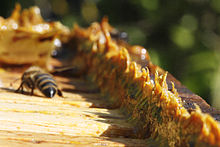Propolis
What it is and used for
For centuries,
beekeepers assumed that bees sealed the beehive with propolis to protect the colony from the elements, such as rain and cold winter drafts. However, 20th century research has revealed that bees not only survive, but also thrive, with increased ventilation during the winter months throughout most temperate regions of the world.
Propolis is now believed to
- reinforce the structural stability of the hive
- reduce vibration
- make the hive more defensible by sealing alternate entrances
- prevent diseases and parasites from entering the hive, and to inhibit bacterial growth
- prevent putrefaction within the hive. Bees usually carry waste out of and away from the hive. However if a small lizard or mouse, for example, finds its way into the hive and dies there, bees may be unable to carry it out through the hive entrance. In that case, they would attempt instead to seal the carcass in propolis, essentially mummifying it and making it odorless and harmless.
The composition of propolis varies from hive to hive, from district to district, and from season to season. Normally it is dark brown in color, but it can be found in green, red, black and white hues, depending on the sources of
resin found in the particular hive area. Honey bees are opportunists, gathering what they need from available sources, and detailed analyses show that the chemical composition of propolis varies considerably from region to region, along with the vegetation. In northern
temperate climates, for example, bees collect resins from
trees, such as
poplars and
conifers (the biological role of resin in trees is to seal wounds and defend against bacteria, fungi and insects). Poplar resin is rich in
flavonoids. "Typical" northern temperate propolis has approximately 50 constituents, primarily resins and vegetable
balsams (50%),
waxes (30%),
essential oils (10%), and
pollen (5%). In
neotropical regions, in addition to a large variety of trees, bees may also gather resin from flowers in the genera
Clusia and
Dalechampia, which are the only known plant genera that produce floral resins to attract pollinators.
Clusia resin contains polyprenylated benzophenones.
[5][6][7] In some areas of
Chile, propolis contains
viscidone, a
terpene from
Baccharis shrubs,and in Brazil,
naphthoquinone epoxide has recently isolated from red propolis,and prenylated acids such as 4-hydroxy-3,5-diprenyl cinnamic acid have been documented.An analysis of propolis from
Henan,
China found
sinapinic acid,
isoferulic acid,
caffeic acid and
chrysin, with the first three compounds demonstrating anti-bacterial properties. Also, Brazilian red propolis (largely derived from
Dalbergia ecastaphyllum plant resin) has high relative percentages of the
isoflavonoids 3-Hydroxy-8,9-dimethoxypterocarpan and medicarpin.
Occasionally, worker bees will even gather various caulking compounds of human manufacture, when the usual sources are more difficult to obtain. The properties of the propolis depend on the exact sources used by each individual hive; therefore any potential medicinal properties that may be present in one hive's propolis may be absent from another's, and the distributors of propolis products cannot control such factors. This may account for the many and varied claims regarding medicinal properties, and the difficulty in replicating previous scientific studies investigating these claims. Even propolis samples taken from within a single colony can vary, making controlled clinical tests difficult, and the results of any given study cannot be reliably extrapolated to propolis samples from other areas.
Medical uses
Propolis is marketed by
health food stores as a
traditional medicine, and for its claimed beneficial effect on
human health.
Natural medicine practitioners use propolis for the relief of various conditions, including
inflammations, viral diseases,
ulcers, superficial burns or scalds.
[citation needed]
Propolis is also believed to promote heart health, strengthen the immune system and reduce the chances of
cataracts.Old
beekeepers[citation needed] recommend a piece of propolis kept in the mouth as a remedy for a sore throat. Propolis
lozenges and tinctures can be bought in many countries. Though claims have been made for its use in treating
allergies, propolis may cause severe allergic reactions if the user is sensitive to bees or bee products.
Some of these claims are being clinically investigated and several studies are published in the biomedical literature.Since the chemical composition of propolis varies depending on season, bee species and geographic location, caution must be applied in extrapolating results (as above).
As an antimicrobial
Depending upon its composition, propolis may show powerful local
antibiotic and
antifungal properties.
As an emollient
Studies also indicate that it may be effective in treating skin burns.
As an immunomodulator
Propolis also exhibits immunomodulatory effects.
As a dental antiplaque agent
Propolis is a subject of recent dentistry research, since there is some evidence that propolis may actively protect against
dental caries and other forms of oral disease, due to its antimicrobial properties.
[ Propolis can also be used to treat
canker sores. Its use in
canal debridement for
endodontic procedures has been explored in Brazil.
As an antitumor growth agent
Propolis' use in inhibiting
tumorigenesis has been studied in mice in Japan.In pre-clinical models of human breast cancer, propolis induces cell cycle arrest,
apoptosis and reduces expression of growth and
transcription factors, including
NF-κB. Notably,
caffeic acid phenethyl ester down-regulates mdr-1 gene, considered responsible for the resistance of cancer cells to chemotherapeutic agents.
Commercial uses
In musical instruments
Propolis is used by certain music instrument makers to enhance the appearance of the wood grain. It is a component of some varnishes and was reportedly used by
Antonio Stradivari.
In food
Propolis is used by some chewing gum manufacturers to make Propolis Gum.
Car wax
Propolis is used to bring about a chemical reaction to convert fats and oils into automobile
wax during application.

No comments:
Post a Comment